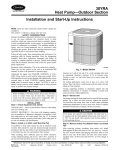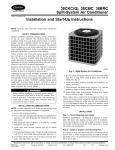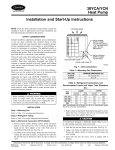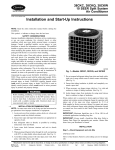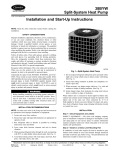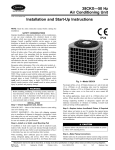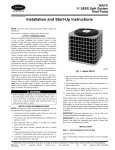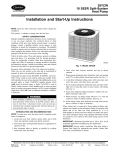Download Carrier 38BYC Instruction manual
Transcript
38YCC(Q), 38AYC, 38BYC Split-System Heat Pump Visit www.carrier.com Installation and Start-Up Instructions NOTE: Read the entire instruction manual before starting the installation. SAFETY CONSIDERATIONS Improper installation, adjustment, alteration, service, maintenance, or use can cause explosion, fire, electrical shock, or other conditions which may cause death, personal injury, or property damage. Consult a qualified installer, service agency, or your distributor or branch for information or assistance. The qualified installer or agency must use factory-authorized kits or accessories when modifying this product. Refer to the individual instructions packaged with the kits or accessories when installing. Follow all safety codes. Wear safety glasses, protective clothing, and work gloves. Use quenching cloth for brazing operations. Have fire extinguisher available. Read these instructions thoroughly and follow all warnings or cautions included in literature and attached to the unit. Consult local building codes and National Electrical Code (NEC) for special requirements. Recognize safety information. This is the safety-alert symbol . When you see this symbol on the unit and in instructions or manuals, be alert to the potential for personal injury. Understand the signal words DANGER, WARNING, and CAUTION. These words are used with the safety-alert symbol. DANGER identifies the most serious hazards which will result in severe personal injury or death. WARNING signifies hazards which could result in personal injury or death. CAUTION is used to identify unsafe practices which would result in minor personal injury or product and property damage. Before installing, modifying, or servicing system, main electrical disconnect switch must be in the OFF position. There may be more than 1 disconnect switch. Lock out and tag switch with a suitable warning label. Electrical shock can cause personal injury or death. INSTALLATION RECOMMENDATIONS NOTE: In some cases noise in the living area has been traced to gas pulsations from improper installation of equipment. 1. Locate unit away from windows. 2. Ensure that vapor and liquid tube diameters are appropriate to capacity of unit. 3. Run refrigerant tubes as directly as possible by avoiding unnecessary turns and bends. 4. Leave some slack between structure and unit to absorb vibration. 5. When passing refrigerant tubes through the wall, seal opening with RTV or other pliable silicon-based caulk. (See Fig. 2.) 6. Avoid direct tubing contact with water pipes, ductwork, floor joists, wall studs, floors, and walls. A97005 Fig. 1—Split-System Heat Pump 7. Do not suspend refrigerant tubing from joists and studs with a rigid wire or strap which comes in direct contact with tubing. (See Fig. 2.) 8. Ensure that tubing insulation is pliable and completely surrounds vapor tube. 9. When necessary, use hanger straps which are 1 in. wide and conform to shape of tubing insulation. (See Fig. 2.) 10. Isolate hanger straps from insulation by using metal sleeves bent to conform to shape of insulation. When outdoor unit is connected to factory-approved indoor unit, outdoor unit contains system refrigerant charge for operation with indoor unit of the same size when connected by 15 ft of field-supplied or factory accessory tubing. For proper unit operation, check refrigerant charge using charging information located on control box cover. INSTALLATION Step 1—Check Equipment and Jobsite INSPECT EQUIPMENT — File claim with shipping company prior to installation if shipment is damaged or incomplete. Locate unit rating plate on unit service panel. It contains information needed to properly install unit. Check rating plate to be sure unit matches job specifications. Step 2—Install on a Solid, Level Mounting Pad If conditions or local codes require the unit be attached to pad, tiedown bolts should be used and fastened through knockouts provided in unit base pan. Refer to Fig. 3 for pad dimensions and dimensions needed to mount unit to pad. Manufacturer reserves the right to discontinue, or change at any time, specifications or designs without notice and without incurring obligations. Book 1 4 PC 101 Catalog No. 533-846 Printed in U.S.A. Form 38AYC-1SI Pg 1 2-97 Replaces: NEW Tab 5a 5a NOTE: Avoid contact between tubing and structure OUTDOOR WALL INDOOR WALL CAULK C LIQUID TUBE VAPOR TUBE INSULATION THROUGH THE WALL 3⁄8″D. (9.53) TIEDOWN JOIST HANGER STRAP (AROUND VAPOR TUBE ONLY) KNOCKOUTS (2) PLACES A INSULATION B VAPOR TUBE A94199 MIN. PAD DIM. (IN.) UNIT SIZE 38YCC(Q)018-030 38AYC018 38BYC018 38YCC(Q)036-060 38AYC024-060 38BYC024-060 1″ MIN. LIQUID TUBE SUSPENSION A94028 Fig. 2—Connecting Tubing Installation TIEDOWN KNOCKOUT LOCATIONS A B C (In.) (In.) (In.) 22-1/2 X 22-1/2 3-11/16 18-1/8 14-3/8 30 X 30 6-1/2 23-1/2 20 Fig. 3—Mount Unit to Pad Step 3—Clearance Requirements Step 6—Metering Device When installing, allow sufficient space for airflow clearance, wiring, refrigerant piping, and service. Common clearances are 6 in. on 1 side, 12 in. on 2 sides, and 30 in. on service side of unit. Allow 24 in. between units. Discharge air must be unobstructed and must not recirculate. NOTE: A thermostatic expansion valve (TXV) is required on all 38BYC units. Step 7 refers to installation of the TXV. Remove indoor coil piston if unit is to be installed on system with a TXV metering device. Position so snow, ice, or water from roof or eaves cannot fall directly on unit. If unit is being installed with piston, check indoor coil piston to see if it matches the required piston shown on outdoor unit rating plate. If it does not match, replace indoor coil piston with piston shipped with outdoor unit. The piston shipped with outdoor unit is correct for any approved indoor coil combination. On rooftop applications, locate unit at least 6 in. above roof surface. Place unit above a load-bearing wall and isolate unit and tubing set from structure. Arrange supporting members to adequately support unit and minimize transmission of vibration to building. Consult local codes governing rooftop applications. Step 7—Remove Indoor AccuRater® Piston and Install TXV Step 4—Operating Ambients The minimum outdoor operating ambient in cooling mode is 55°F, and the maximum outdoor operating ambient in cooling mode is 125°F. The maximum outdoor operating ambient in heating mode is 66°F. For proper unit operation and reliability, units must be installed with a field-supplied hard shut-off TXV. Do not install with evaporator coils having capillary tube metering devices or piston. Step 5—Elevate Unit After removing existing AccuRater from indoor coil, install field-supplied bi-flow hard shut-off TXV kit. (See Fig. 4 and 5.) For TXV kit part number and charging instruction, refer to TXV label on your unit. If indoor unit (fan coil) comes factory equipped with a bi-flow hard shut off TXV, no TXV change is required. Accumulation of water and ice in base pan may cause equipment damage. In areas where prolonged freezing temperatures are encountered, elevate unit per local climate and code requirements to provide clearance above estimated snowfall level and ensure adequate drainage of unit. Install TXV kit to indoor coil as follows: 1. Install suction tube adapter. 2. Install liquid flare-to-sweat adapter. 2 and condition. For tubing requirements beyond 50 ft, consult your local distributor or the Long-Line Application Guideline. Refer to Fig. 6 for refrigerant tube dimensions and connections. COIL AIR DISCHARGE SENSING BULB EQUALIZER TUBE FIELD POWER SUPPLY CONN 7⁄8″ DIA HOLE WITH 1 1⁄8″ DIA KNOCKOUT AND 1 3⁄8″ DIA KNOCKOUT THERMOSTATIC EXPANSION VALVE A88382 Fig. 4—Typical TXV Installation 10 O'CLOCK 2 O'CLOCK SUCTION LINE CONN FIELD CONTROL SUPPLY CONN 7⁄8″ DIA HOLE LIQUID LINE CONN SENSING BULB A97009 STRAP UNIT SIZE 018, 024 030, 036 042, 048 060 SUCTION TUBE 4 O'CLOCK 8 O'CLOCK 7⁄8 IN. OD & SMALLER LARGER THAN 7⁄8 LIQUID TUBE Conn Dia Tube Dia 3/8 3/8 3/8 3/8 3/8 3/8 3/8 3/8 VAPOR TUBE Conn Dia Tube Dia 5/8 5/8 3/4 3/4 7/8 7/8 7/8 1-1/8 NOTE: Tube diameters are for lengths up to 50 ft. For tubing lengths greater than 50 ft, consult your local distributor. IN. OD Fig. 6—Refrigerant Tube Dimensions/Connections A81032 Fig. 5—Positioning of Sensing Bulb MECHANICAL CONNECTION (38YCQ MODEL) 3. Connect external equalizer tube to fitting on suction tube adapter. 1. Remove plastic retainer holding outdoor piston and piston retainer in liquid service valve. Connect and tighten liquid service valve adapter to valve body prior to assembling ferrule/lock nut. (See Fig. 7.) 4. Position sensing bulb on horizontal portion of suction tube adapter. Secure using supplied hardware. 5. Insulate bulb after installation. (See Fig. 5.) 2. Cut tubing to correct length, deburr and size as necessary, making sure tube ends are square. If a large burr is evident, ID and OD must be deburred to allow tube to bottom in valve. 6. Leak check all connections. Step 8—Make Tubing Connections 3. Remove lock nut and ferrule from plastic bag taped to service panel. (See Fig. 8.) Remove lock nut and ferrule from liquid service valve adapter. (See Fig. 7.) Relieve pressure and recover all refrigerant before system repair or final unit disposal to avoid personal injury or death. Use all service ports and open all flow-control devices, including solenoid valves. If undersized, damaged, or elliptically shaped tubing is used when making connection, leaks could result. 4. Slide lock nut and ferrule onto each tube. (See Fig. 9.) To prevent compressor damage DO NOT bury more than 36 in. of refrigerant tubing. If ANY tubing is buried, provide 6 in. vertical rise at service valve. 5. Apply a few drops of refrigerant oil to ferrule and valve threads and adapter threads to reduce assembly torque and assist sealing. 6. Insert tube end into service valve or adapter until it bottoms. To prevent damage to unit or service valves observe the following: • Use a brazing shield. • Wrap service valves with wet cloth or use a heat sink material. 7. Push ferrule into place and hand tighten nut until an increase in torque is felt. Connect outdoor unit to indoor sections using accessory tubing package or field-supplied tubing of refrigerant grade, correct size, NOTE: A backup wrench on the hex part of the suction valve fitting is required while tightening. 8. Mark nut and tube and tighten 1-1/2 turns from the mark. (See Fig. 10.) Keep tube bottomed in valve and adapter while tightening nut. 3 3. When suction pressure reaches 5 psig, shut unit off. Do not operate unit in a vacuum. PISTON BODY 4. Close suction service valve and recover refrigerant in tubing. 5. Back-off locknut and ferrule onto tube. 6. Remove damaged part of tubing using tubing cutter. Repeat installation procedure previously outlined using new ferrule. 7. Evacuate tubing set and indoor coil. Check for leaks. 8. Open service valves or recharge unit. Check refrigerant charge. PISTON PISTON RETAINER LOCK NUT LIQUID SERVICE VALVE ADAPTER FERRULE LOCK NUT A94030 Fig. 7—Liquid Service Valve Mechanical Fitting Assembly (38YCQ Model) TUBING VALVE FITTING MARK ON LOCK NUT AND TUBE FERRULE A92122 Fig. 10—Proper Marking of Valve Assembly If refrigerant tubing or indoor coil is exposed to atmosphere, it must be evacuated to a minimum of 500 microns to eliminate contamination and moisture in the system. SWEAT CONNECTION 1. Consult local code requirements. LOCK NUT A92120 2. Remove plastic retainer holding outdoor piston in the liquid service valve and connect sweat/flare adapter provided to valve. (See Fig. 11.) Fig. 8—Suction Service Valve with Mechanical Adapter (38YCQ Model) 3. Connect refrigerant tubing to fittings on outdoor uit vapor and liquid service valves. FERRULE 4. Service valves are closed from factory and ready for brazing. LOCK NUT 5. After wrapping service valve with a wet cloth, tubing set can be brazed to service valve using either silver bearing or non-silver bearing brazing material. 6. Refrigerant tubing and indoor coil are now ready for leak testing. This check should include all field and factory joints. Step 9—Make Electrical Connections TUBING To avoid personal injury or death, do not supply power to unit with compressor terminal box cover removed. A92121 Fig. 9—Lock Nut/Ferrule Positioning Be sure field wiring complies with local and national fire, safety, and electrical codes, and voltage to system is within limits shown on unit rating plate. Contact local power company for correction of improper voltage. See unit rating plate for recommended circuit protection device. The tube end must stay bottomed in the service valve during final assembly to ensure proper seating, sealing, and rigidity. 1. Attach gages to service valves. NOTE: Operation of unit on improper line voltage constitutes abuse and could affect unit reliability. See unit rating plate. Do not install unit in system where voltage or phase imbalance (3 phase) may fluctuate above or below permissible limits. 2. Close liquid service valve and operate unit in cooling mode to pump refrigerant charge into condenser coil. NOTE: Use copper wire only between disconnect switch and unit. MECHANICAL FITTING REPAIR To replace damaged ferrule or tubing, proceed as follows. 4 Use furnace transformer, fan coil transformer, or accessory transformer for control power, 24-v/40-va minimum. PISTON BODY NOTE: Use of available 24-v accessories may exceed the minimum 40-va power requirement. Determine total transformer loading and increase the transformer capacity or split the load with an accessory transformer as required. NOTE: The defrost timer is factory set for 90-minute cycles. The timer can be field set for 30- and 50-minute cycles depending on defrost conditions in your geographical location. PISTON Step 10—Compressor Crankcase Heater PISTON RETAINER When equipped with a crankcase heater, energize heater a minimum of 24 hr before starting unit. To energize heater only, set thermostat to OFF and close electrical disconnect to outdoor unit. SWEAT/FLARE ADAPTER A crankcase heater is required if refrigerant tubing is longer than 50 ft. A94029 NOTE: The Seasonal Energy Efficiency Ratio (SEER) and Heating Seasonal Performance Factor (HSPF) is obtained with the crankcase heater de-energized. To de-energize the crankcase heater, disconnect black crankcase heater wires at contactor. After disconnecting, make sure wires are isolated from all other electrical connections and components to prevent electrical shorting. Fig. 11—Liquid Service Valve NOTE: Install branch circuit disconnect per NEC of adequate size to handle unit starting current. Locate disconnect within sight from and readily accessible from unit, per Section 440-14 of NEC. Step 11—Install Electrical Accessories ROUTE GROUND AND POWER WIRES — Remove access panel to gain access to unit wiring. Extend wires from disconnect through power wiring hole provided and into unit control box. Refer to the individual instructions packaged with kits or accessories when installing. Step 12—Start-Up and Check Charge The unit cabinet must have an uninterrupted or unbroken ground to minimize personal injury if an electrical fault should occur. The ground may consist of electrical wire or metal conduit when installed in accordance with existing electrical codes. Failure to follow this warning can result in an electric shock, fire, or death. To prevent compressor damage or personal injury, observe the following: • Do not overcharge system with refrigerant. • Do not operate unit in a vacuum or at negative pressure. • Do not disable low-pressure switch In scroll compressor applications: • Dome temperatures may be hot. • In 3 phase application, incorrect phasing will cause reverse rotation, resulting in elevated noise levels, equalized pressures, and reduced current draw. Correct by reversing power connection L1 and L2 on contactor. CONNECT GROUND AND POWER WIRES — Connect ground wire to ground connection in control box for safety. Connect power wiring to contactor as shown in Fig. 12. DISCONNECT PER N.E.C. AND/OR LOCAL CODES CONTACTOR To prevent personal injury wear safety glasses, protective clothing, and gloves when handling refrigerant and observe the following: • Back seating service valves are not equipped with Schrader valves. Fully back seat (counter clockwise) valve stem before removing gage port cap. • Front seating service valves are equipped with Schrader valves. FIELD POWER WIRING 3 PHASE ONLY BLUE FIELD GROUND WIRING GROUND LUG A94025 Do not vent refrigerant to atmosphere. Recover during system repair or final unit disposal. Fig. 12—Line Power Connections Follow these steps to properly charge a system. CONNECT CONTROL WIRING — Route 24-v control wires through control wiring grommet and connect leads to control wiring. (See Fig. 13) 1. Fully back seat (open) liquid and vapor tube service valves. 2. Unit is shipped with valve stem(s) front seated (closed) and caps installed. Replace stem caps after system is opened to refrigerant flow. Replace caps finger-tight and tighten with wrench an additional 1/6 turn for front seating valves (female hex stem) or 1/12 turn for back seating valves (male square stem). Use No. 18 AWG color-coded, insulated (35°C minimum) wire. If thermostat is located more than 100 ft from unit (as measured along the control voltage wires), use No. 16 AWG color-coded wire to avoid excessive voltage drop. 5 3. Close electrical disconnects to energize system. Should temperature continue to fall, R-W2 is made through second-stage room thermostat bulb. Circuit R-W2 energizes a sequencer, bringing on first bank of supplemental electric heat and providing electrical potential to second heater sequencer (if used). If outdoor temperature falls below setting of outdoor thermostat (field-installed option), contacts close to complete circuit and bring on second bank of supplemental electric heat. 4. Set room thermostat at desired temperature. 5. Set room thermostat to HEAT or COOL and fan to ON or AUTO mode, as desired. Operate unit for 15 minutes. Check system refrigerant charge. 6. Factory charge is shown on outdoor unit rating plate. Adjust charge in cooling mode by following procedure shown on the charging table. Check charge in heating mode by following procedure shown on heating check chart. Both are located on outdoor unit. When thermostat is satisfied, its contacts open, de-energizing the contactor and sequencer. All heaters and motors should stop. Defrost SEQUENCE OF OPERATION NOTE: Defrost control board may be equipped with 5-minute lockout timer which may be initiated upon any interruption of power. The defrost control is a time/temperature control which includes a field-selectable (quick-connects located at board edge) time period between defrost cycles (30, 50, and 90 minutes), factory set at 90 minutes. With power supplied to indoor and outdoor units, transformer is energized. The electronic timer and defrost cycle start only when contactor is energized and defrost thermostat is closed. Cooling The defrost mode is identical to cooling mode except that outdoor fan motor stops and second-stage heat is turned on to continue warming conditioned space. On a call for cooling, thermostat makes circuits R-O, R-Y, and R-G. Circuit R-O energizes reversing valve, switching it to cooling position. Circuit R-Y energizes contactor, starting outdoor fan motor and compressor circuit. R-G energizes indoor unit blower relay, starting the indoor blower motor on high speed. CARE AND MAINTENANCE For continuing high performance and to minimize possible equipment failure, it is essential that periodic maintenance must be performed on this equipment. When the thermostat is satisfied, its contacts open, de-energizing the contactor and blower relay. Compressor and motors should stop. Leave User’s Manual with homeowner. Explain system operation and periodic maintenance requirements outlined in manual. Frequency of maintenance may vary depending upon geographic areas, such as coastal applications which require more frequent maintenance. NOTE: If indoor unit is equipped with a time-delay relay circuit, the blower will run an additional 90 sec to increase system efficiency. Heating On a call for heating, thermostat makes circuits R-Y and R-G. Circuit R-Y energizes contactor, starting outdoor fan motor and compressor. Circuit R-G energizes indoor blower relay, starting blower motor on high speed. 6 CORPORATE NON-PROGRAMMABLE THERMOSTAT MODEL HP FA, FB, FC, FD, FF FAN COIL CORPORATE PROGRAMMABLE THERMOSTAT MODEL HP HEAT PUMP 24 VAC HOT R R R 24 VAC COM C C C W2 W2 24 VAC HOT R R INDOOR FAN G G HEAT STAGE 2 HEAT STAGE 2 COOL/HEAT STAGE 1 INDOOR FAN W/W1 Y/Y2 G COOL/HEAT STAGE 1 Y RVS COOLING G NOT USED RVS COOLING O/W2 NOT USED Y1 NOT USED B TROUBLE L OPTIONAL OUTDOOR SENSOR CONNECTION FA, FB, FC, FD, FF FAN COIL W/W1 W2 HEAT PUMP R W2 Y/Y2 Y O/W2 O Y1/W2 O 24 VAC COM C NOT USED B TROUBLE L OPTIONAL OUTDOOR SENSOR CONNECTION S1 S2 C C S1 S2 A94390 Fig. 13—Typical 24-v Circuit Connections 7 A94391 CORPORATE NON-PROGRAMMABLE THERMOSTAT MODEL HP 24 VAC HOT 24 VAC COM HEAT STAGE 2 COOL/HEAT STAGE 1 INDOOR FAN R C W/W1 FK4B FAN COIL R C W2 Y/Y2 Y/Y2 G G HEAT PUMP CORPORATE PROGRAMMABLE THERMOSTAT MODEL HP R O/W2 O NOT USED Y1 Y1 NOT USED B E TROUBLE L L OPTIONAL OUTDOOR SENSOR CONNECTION HEAT PUMP C W2 Y W3 RVS COOLING FK4B FAN COIL O 24 VAC HOT R R INDOOR FAN G G HEAT STAGE 2 W/W1 W2 W2 COOL/HEAT STAGE 1 Y/Y2 Y/Y2 Y RVS COOLING O/W2 O O NOT USED Y1/W2 W3 24 VAC COM C C NOT USED B E TROUBLE L L OPTIONAL OUTDOOR SENSOR CONNECTION S1 R C S1 S2 S2 A94392 A94393 Fig. 13—Typical 24-v Circuit Connections (Continued) 8 NON-CORPORATE NON-PROGRAMMABLE THERMOSTAT MODEL HP FK4B FAN COIL HEAT PUMP 24 VAC HOT R R R 24 VAC COM C C C HEAT STAGE 2 COOL/HEAT STAGE 1 INDOOR FAN W W2 W2 Y Y/Y2 Y G G NON-CORPORATE NON-PROGRAMMABLE THERMOSTAT MODEL HP W3 RVS COOLING O O O FA, FB, FC, FD, FF FAN COIL HEAT PUMP 24 VAC HOT R R R 24 VAC COM C C C HEAT STAGE 2 W W2 W2 COOL/HEAT STAGE 1 Y INDOOR FAN G RVS COOLING O EMERGENCY HEAT E Y G O Y1 EMERGENCY HEAT E E L A95280 A95279 NOTES: 1. CORPORATE THERMOSTAT WIRING DIAGRAMS ARE ONLY ACCURATE FOR MODEL NUMBERS BEGINNING WITH TSTAT _ _ _ _ _ _ _ 2. WIRING MUST CONFORM TO NEC OR LOCAL CODE. 3. SOME UNITS ARE EQUIPPED WITH PRESSURE SWITCH(ES), TEMPERATURE SWITCH, OR 5 MINUTE COMPRESSOR CYCLE PROTECTION. CONNECT 24 VOLT FIELD WIRING TO FACTORY PROVIDED STRIPPED LEADS. 4. A LIQUID LINE SOLENOID VALVE IS REQUIRED ON SOME UNITS. SEE SPECIFIC UNIT INSTRUCTIONS. 5. THERMOSTATS ARE FACTORY CONFIGURED WITH 5 MINUTE COMPRESSOR CYCLE PROTECTION AND 4 CYCLES PER HOUR LIMIT. SEE THERMOSTAT INSTRUCTIONS FOR DETAILS. 6. TO STAGE THE ELECTRIC RESISTANCE HEAT, CONSULT OUTDOOR THERMOSTAT INSTALLATION INSTRUCTIONS. LEGEND 24 VOLT FACTORY WIRING 24 VOLT FIELD WIRING FIELD SPLICE CONNECTION C CONTACTOR A94394 Fig. 13—Typical 24-v Circuit Connections (Continued) 9 10 11 Copyright 1997 CARRIER Corp. • 7310 W. Morris St. • Indianapolis, IN 46231 38ayc1si Manufacturer reserves the right to discontinue, or change at any time, specifications or designs without notice and without incurring obligations. Book 1 4 PC 101 Catalog No. 533-846 Printed in U.S.A. Form 38AYC-1SI Pg 12 2-97 Replaces: NEW Tab 5a 5a












